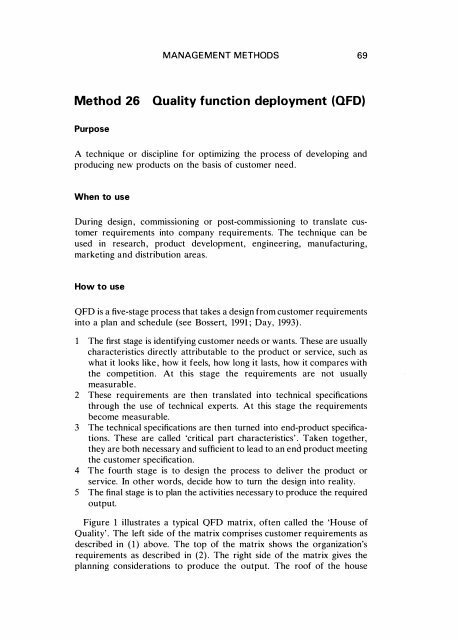100-Metodos-de-Qualidade-Total
You also want an ePaper? Increase the reach of your titles
YUMPU automatically turns print PDFs into web optimized ePapers that Google loves.
MANAGEMENT METHODS 69<br />
Method 26<br />
Quality function <strong>de</strong>ployment (QFO)<br />
Purpose<br />
A technique or discipline for optimizing the process of <strong>de</strong>veloping and<br />
producing new products on the basis of customer need.<br />
When to use<br />
During <strong>de</strong>sign, commissioning or post-commissIOning to translate customer<br />
requirements into company requirements. The technique can be<br />
used in research, product <strong>de</strong>velopment, engineering, manufacturing,<br />
marketing and distribution areas.<br />
How to use<br />
QFD is a five-stage process that takes a <strong>de</strong>sign from customer requirements<br />
into a plan and schedule (see Bossert, 1991 ; Day, 1993).<br />
1 The first stage is i<strong>de</strong>ntifying customer needs or wants. These are usually<br />
characteristics directly attributable to the product or service, such as<br />
what it looks like, how it feels, how long it lasts, how it compares with<br />
the competition. At this stage the requirements are not usually<br />
measurable.<br />
2 These requirements are then translated into technical specifications<br />
through the use of technical experts. At this stage the requirements<br />
become measurable.<br />
3 The technical specifications are then turned into end-product specifications.<br />
These are called 'critical part characteristics'. Taken together,<br />
they are both necessary and sufficient to lead to an end product meeting<br />
the customer specification.<br />
4 The fourth stage is to <strong>de</strong>sign the process to <strong>de</strong>liver the product or<br />
service. In other words, <strong>de</strong>ci<strong>de</strong> how to turn the <strong>de</strong>sign into reality.<br />
5 The final stage is to plan the activities necessary to produce the required<br />
output.<br />
Figure 1 illustrates a typical QFD matrix, often called the 'House of<br />
Quality'. The left si<strong>de</strong> of the matrix comprises customer requirements as<br />
<strong>de</strong>scribed in (1) above. The top of the matrix shows the organization's<br />
requirements as <strong>de</strong>scribed in (2). The right si<strong>de</strong> of the matrix gives the<br />
planning consi<strong>de</strong>rations to produce the output. The roof of the house


